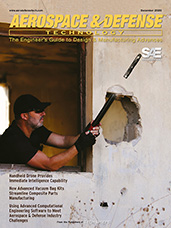Aerospace & Defense Technology
December 2020
- How Solid-State Technology Impacts A&D Equipment Testing
- The Role of Prototype/Test Systems in Next-Generation C5ISR Development
- Using Advanced Computational Engineering Software to Meet Aerospace & Defense Industry Challenges
- How Advanced Vacuum Bag Kits Streamline Composite Parts Manufacturing
- Replacing Multiple RF Receivers with Just One Using Channelization
- Air Force Technology Tracks "Sporadic E"
- Progress on Zirconia-Polyurea Matrix Hybrid Composites
Incorporating zirconia particles into polyurea elastomers to form hybrid composites and designing them into state-of-the-art body armor has the potential to achieve lightweight ballistic efficiency. - Bioenvironmental Engineering Guide for Composite Materials
Developing a comprehensive baseline for identifying, evaluating, and controlling occupational and environmental hazards associated with composite fibers and materials for base-level Bioenvironmental Engineering (BE) personnel. - Designing Sensory and Adaptive Composite Materials
Newly developed computational approaches aid in the design of composites that exhibit remarkable abilities to both sense external cues and adapt to these cues in controllable, 'programmable' ways. - Design of New Piezoelectric Composites Using Nanocellulose
Using cellulose crystals as building blocks for the design and development of new low-density functional polymer composites. - Fast Reacting Nano-Composite Energetic Materials: Synthesis and Combustion Characterization
The advent of nanoparticle fuels enables traditionally diffusive controlled reactions to transition towards kinetically dominant reactions, a transition that results in faster reacting formulations that show promise of harnessing the power equivalent to a monomolecular explosive, but packaged as discretely separate fuel and oxidizer composites.
Related Topics:

